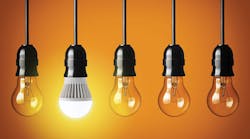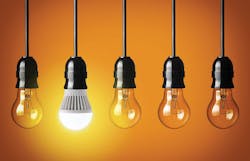The lighting industry is in the midst of a major transformation, resulting from the U.S. government’s push for energy savings. Because lighting accounts for between 20% to 40% of a building’s electrical load, regulators constantly want improved lighting energy performance. Therefore, lighting is becoming a proactive agent of change as we learn more about spectral distribution, the physics of color, the physiology of vision, and the relationship between light and health.
Reviewing some of the developments seen in the aisles at the 2014 Lightfair International show gives us an idea of what lies ahead. Here are three major lighting trends you should know about:
Solid-state illumination will dominate new growth
The LED light source is not the only game in town, but it sure is capturing all of the attention right now. It opens the door for a whole new presentation of what electrical illumination can, and will, do for us. Last year, for the first time since 1911 — when the Illuminating Engineering Society Progress Committee was formed — no luminaires using incandescent, fluorescent, or HID sources were named in the 2014 IES Progress Report, which showcases products that provide significant technical advancement in the art and science of lighting.
This means that with the LED chip continually improving in efficacy, longevity, and cost, the general lighting market in commercial, institutional, and industrial projects will eventually shift to solid-state lighting in some form or another.
The organic LED (OLED) source is a complementary technology experiencing gains in performance and reductions in cost. An OLED consists of stacked organic (carbon-based) thin films sandwiched between two current-carrying electrodes, which are typically enclosed in plastic or glass, providing diffused light with little glare. These panels have a source brightness ranging from 2,000 to 6,500 candelas per square meter, and the output can be monochromatic (single color) or it can be color tunable using a red, blue, and green source mix. An OLED panel can integrate with architectural materials and surfaces, such as walls, ceilings, or furniture, and efficiencies are expected to breach 80 lm/W. However, until there is a significant change in the vacuum thermal evaporation (VTE) manufacturing process (a slow and expensive method), the OLED source will remain expensive for general illumination.
Other solid-state lighting technologies, such as glowing graphene sheets, may develop and partner with LEDs for specific lighting applications. In general, however, as solid-state lighting continues to develop, code-mandated lighting power densities will also likely decrease.
Connected and responsive lighting will offer unprecedented control
Architects, building owners, and users, along with lighting designers and electrical engineers, understand that the LED source is inherently controllable through its driver. And digital technology can offer better data input, conversion, and application scenarios than ever before, since the processing power of a PC has been shrinking and finding a home within a tiny chip in both luminaires and lamps. Sensors embedded in luminaires can gather data not only from photocells and proximity/occupancy detectors, but also determine carbon dioxide and sound energy levels (among other parameters) using low-power microprocessors. Overhead luminaires can recognize when a specific person is working in an office and customize the surrounding lighting scene. The same luminaires can be programmed to provide constant light and color output over their rated life, thus achieving longer service life and consistent white color temperature.
Other trends to note regarding luminaires for general lighting include: the wide range of color temperatures offered both as adjustable CCT and warm dimming options; drivers that use multiple dimming protocols; control features with self-commissioning and remote control configurations; and controls that stress code requirements rather that actively managing energy consumption. In addition, the industry has its first solid-state dimming standard, NEMA 7A- 2013, which addresses the incompatibility of some dimmers and LED luminaires with the goal of achieving better performance and reliability.
While onboard analog control sensors first appeared in linear fluorescent fixtures years ago, today’s digitally addressable fixtures offer a more granular degree of control and flexibility for a variety of components attached to a network. For example, an emerging control capability is having LED lighting communicate messages and provide way-finding at retail facilities and other locations. Retailers can now set up a visual light communication (VLC) system, which involves modulating the output of the overhead LED lighting system to create a coded signal (rapid light pulses) that can be received and detected by the customers’ cell phone camera. The system, which can be used as a standalone solution or in a supplementary role to radio-frequency (RF) or cellular network communications, can help guide customers to products within the store.
Recognizing that touchscreens and mobile devices are the advanced guard for the application of ubiquitous wireless communications in lighting control and elsewhere, both indoor and outdoor lighting fixtures can easily become part of a network that delivers data back to wherever it is needed, using both wired and wireless circuits.
The introduction of upgraded wireless protocols and standards, such as Zigbee, Bluetooth, and the new IEEE 802.11ac standard, makes network communications within a building easier. In particular, several features found in the new 802.11ac standard will be important for lighting use, including an increase in channel bandwidth, support for eight multiple input, multiple output (MIMO) spatial streams, and multiuser MIMO. Many facilities are deploying a much denser wireless LAN network, with an increasing number of access points being installed to handle building automation needs as well as laptop and smartphone users.
We can imagine that, in the future, all of the general lighting in the tenant-occupied spaces of a typical building will be wirelessly controlled through the Web or mobile apps using an open standard, a fixed network protocol, or a hybrid of the two — while recognizing that security is both a challenge and an opportunity.
Pay attention to the link between lighting and health
Because LED sources have high luminance, or source brightness, compared to legacy light sources — and because they usually lack a full color spectrum — individual LEDs in an array, phosphors, and electronic dimming can work together to create lighting tailored to support performance and human health.
Research is showing that the specific color produced by the LED chip within a luminaire can enhance human visual performance and offer therapeutic treatment value. While scientists continue to develop a deeper understanding of the link between light and health, people in the medical field are learning that arrays of color-changing LEDs can be programmed to replicate outdoor lighting conditions at different times of the day to help regulate circadian phase shift disorders — or more specifically, that blue light can be used to activate the circadian system.
Specialists suggest that during the active parts of the day, blue light (around 460 nm) should be present in larger quantities to support hormone production for alertness and activity. If blue light is then removed later in the day, it stimulates a reduction in cortisol, a hormone correlated with wakefulness, and the production of melatonin, which is associated with proper sleep and cognition, increases. Health care experts say the best way to accommodate circadian light is to have a luminaire, or the placement of light from a luminaire, simulate the appearance of the sky to stimulate a circadian response, a task easily handled by LED luminaires and controls. Using circadian rhythm lighting and putting control of color temperature and brightness in the hands of the staff and patients is an important trend.
Another indoor lighting application of a “tunable” white LED source is the ability to provide a “dim-to-warm” characteristic (for ambiance) that can mimic the way incandescent and halogen lamps dim, with the color temperature of the source becoming warmer as the light level drops.
SIDEBAR: Move to More Stringent Building Codes
Look for building codes to continuously become more restrictive. One of the nation’s top three building energy codes and standards — ANSI/ASHRAE/IES Standard 90.1 — 2013, Part 6 of Title 24 of the California Code of Regulations, and the International Energy Conservation Code (IECC) — are generally used by individual states as a reference model. For example, the ASHRAE 90.1-2013 standard has daylighting design criterial along with daylighting controls and space-by-space power densities. The California Title 24-2013 rules have lowered compliance thresholds significantly, meaning that even modest retrofits or lighting upgrades may trigger code compliance for basic requirements, such as automatic lighting shutoff. The codes are also becoming increasingly performance-based. For instance, the latest version of the IECC includes an additional performance-based pathway, which is already popular in many states.




